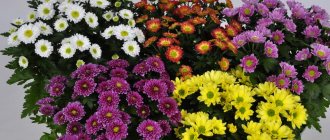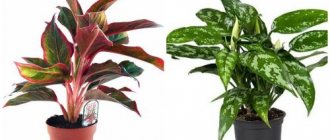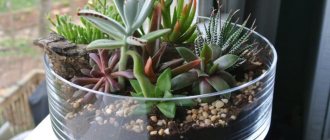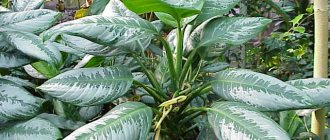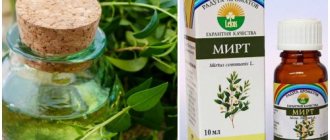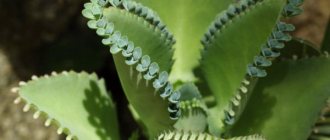Author: Elena N. https://floristics.info/ru/index.php?option=com_contact&view=contact&id=19 Category: Houseplants Published: February 27, 2017Last edits: April 15, 2021
- Care during flowering
- Growing from seeds
- Diseases and their treatment
- Nepenthes alata
flower (lat. Nepenthes), or pitcher plant, is the only genus of the monotypic family Nepentheaceae. The name “nepenthes” comes from the word “nepenthes” - this is what the herb of oblivion was called in ancient Greek mythology. Where does Nepenthes grow? Most of the representatives of this genus grow in the tropics of Asia, in particular on the island of Kalimantan. The distribution border of Nepenthes in the west reaches Madagascar and the Seychelles, and in the east – New Caledonia, New Guinea and Northern Australia. The predatory plant Nepenthes, which feeds on insects, has strong symbiotic relationships with some representatives of the animal world. For example, large species of the plant are used by mountain tupai as dry toilets: the animals feast on Nepenthes nectar and leave their droppings in the jugs, which serve as fertilizer for the plant. And bats climb into traps to sleep - here they are not bothered by insects and do not have to compete for a sleeping place. As a thank you, the mice leave the plant their excrement, which contains the nitrogen it needs.
Planting and caring for nepenthes
- Flowering: 3 to 7 months in spring and summer.
- Lighting: bright diffused light (southern or eastern window sills with shading during the midday hours). When grown on a northern windowsill in winter, the plant will require additional artificial lighting for 16 hours.
- Temperature: mountain species feel good in the warm season at a temperature of 18-20 ˚C, and in winter at 12-15 ˚C. Lowland Nepenthes prefer temperatures from 22 to 26 ˚C during the period of active growth, and in winter – 16-20 ˚C.
- Watering: regular, preferably through drainage holes. In the warm season, the substrate in the pot should be slightly damp all the time, and in winter it should be allowed to dry to a depth of 5 mm.
- Air humidity: some species require very high humidity - 70-90%; for others, a humidity level of 40% during the day and at least 50% at night is sufficient. Keep Nepenthes on a tray of wet peat or expanded clay and spray its leaves with water daily.
- Fertilizing: Nepenthes is an insectivorous plant and does not require fertilizers. Once a month, place a live bloodworm, fly or spider in one jug, and a different one each time.
- Dormant period: not clearly expressed, but due to operating heating devices, the jugs begin to dry out. In the spring, simply cut the leaves almost to the base, restore the watering regime and water the substrate with a very weak solution of complex mineral fertilizer.
- Replanting: in spring, if absolutely necessary.
- Reproduction: by cuttings, dividing the bush and by seed.
- Pests: aphids and mealybugs.
- Diseases: fungal rot.
Read more about growing Nepenthes below.
Suitable containers
To grow Nepenthes, you can use a variety of dishes:
- clay pots,
- baskets,
- cylindrical pieces of bark, etc.
The main rule for growing Nepenthes is to ensure excellent drainage. Remember: drainage should occupy at least a quarter of the height of the pot. Use as drainage:
- broken shards,
- expanded clay,
- clean bark (2-3 cm fraction).
When planting nepenthes, a layer of drainage is placed on the bottom of the dish, then a layer of fresh substrate. Place the plant with straightened roots on the substrate and cover them with a layer of substrate, leaving approximately 2 cm to the edge of the pot. The best time for planting and transplanting nepenthes is spring.
Botanical description
The insectivorous plant Nepenthes is most often a subshrub or shrubby mixotrophic vine. Nepenthes, with long herbaceous stems, climb branches and tree trunks to many meters in height in search of sunlight for their narrow terminal paniculate or racemose inflorescences. The leaves of Nepenthes are large, alternate, with a convex midrib and an elongated apex.
Venus flytrap - home care
In addition to ordinary leaves, the plant also develops pitcher leaves, the lower part of the petiole of which, connecting to the stem, is flat and wide, and then it transforms into a thin tendril wrapping around a branch, at the end of which hangs a pitcher, similar to an outlandish flower. The size, shape and color of the jug depend on the type of Nepenthes. The length of the trap can be from 2.5 to 30 cm, although there are species with jugs of half a meter. The color of the pitchers is usually bright - matte white, spotted, red or light green with purple dots. The upper edge of the jug is curved inward and covered with purple or pink grooves.
Special cells located on the inner edge of the jug produce sweet nectar, the inside of the jug is filled with water or digestive fluid containing the nepenthesin enzyme, and the neck is covered with a lid that protects the trap from debris getting into it. Insects, attracted by the aroma of nectar, crawl under the cap, slide into the digestive fluid and drown in it. Digestion of food lasts from 5 to 8 hours, as a result of which only the chitinous shell remains of the insects. Sometimes even birds, amphibians and rodents get into the jugs.
- Zamia – care, photos, types
Nepenthes flowers are inconspicuous, dioecious, petalless, with imbricated sepals. The fruit is a leathery capsule, divided by partitions into chambers, in each of which small seeds ripen.
In indoor culture, Nepenthes is still rare, since almost all representatives of the genus are too large for small greenhouses, and it is difficult to keep predatory Nepenthes on a windowsill - it requires high air humidity. It is best to grow nepenthes in greenhouses, and their smaller species in a “closed tropical window.”
Nutrition
A good choice would be Nepenthes, whose organs used to capture insects are very noticeable and much better visible than, for example, sundews. They also have a very interesting shape, resembling a pitcher with a smooth rim (coated with a slippery substance that attracts insects) and a lid that prevents rainwater from getting inside. Inside such a trap, at the very bottom, there is a liquid for digesting victims (for example, in the form of a fly). Lured by the color and special aroma, the insect immediately gets inside the trap and no longer has a chance to get out of it. Slippery walls, curved downwards, reminiscent of the shape of a decanter, effectively retain the captured insect. Of course, Nepenthes does not rely only on this method of nutrition, since it also has green leaves, which are used to produce food through the process of photosynthesis, and in case of shortage of food of organic origin, it feeds in the classical way like ordinary plants.
Caring for Nepenthes at home
Growing conditions
Nepenthes needs bright but diffused light, so it is best to keep the plant on a southern or eastern windowsill, protected from the scorching midday rays with a translucent cloth or paper. When growing a pitcher plant on a western or northern window, provide additional lighting for it. In winter, artificial lighting should work for 16 hours.
According to the requirements for temperature conditions, Nepenthes species can be divided into two groups:
- mountainous - these plants develop comfortably in spring and summer at a temperature of 18-20 ºC, and in winter at 12-15 ºC. Too high a temperature for a long time can provoke the development of diseases;
- lowland nepenthes prefer temperatures from 22 to 26 ºC in summer, but in winter it should be between 16-20 ºC. At lower temperatures, plant life may be at risk.
Ventilate the room regularly so that the air in it does not stagnate, but protect nepenthes from drafts and try to move it as little as possible, because the plant does not like moving and turning around its axis. If you disturb it, Nepenthes may freeze for a month or a month and a half and stop forming pitchers.
Since Nepenthes is a vine, you should prepare a support for it, to which it will need to be tied as soon as it reaches a height of half a meter. It is best to install a support when transplanting a one-year-old plant.
Watering
Caring for Nepenthes includes such a mandatory item as regular moistening of the substrate. To water the plants, use distilled or at least filtered, settled or rainwater at room temperature, or preferably a couple of degrees warmer. The method of watering Nepenthes is from the bottom, after which you must allow excess water to drain. In spring and summer, the substrate in the pot should be slightly moist all the time; in winter, Nepenthes is watered a couple of days after the top 5 mm thick layer of the substrate has dried. If the plant overwinters in a cool place, watering should be careful and not very abundant.
The moisture-loving predator Nepenthes needs not only moist soil - many species also need high air humidity in the range of 70-90%. However, among the pitcher plants grown indoors, there are many that require a humidity level of 40% during the day and 50% at night. Observe the condition of the plant under your usual conditions - it is quite possible that it will be able to adapt to the humidity of the air in your home, but if this does not happen, spray it daily with settled water and place the pot with nepenthes on a tray with damp peat or expanded clay.
Transfer
Nepenthes is replanted only if necessary, which arises, for example, when mold appears on the substrate or the pot no longer corresponds to the size of the root system. Pots, hanging baskets for orchids or flowerpots are used as dishes, and the diameter of the dishes must be at least 14 cm. Store-bought soil for orchids can serve as a substrate.
If you prefer to prepare the soil for nepenthes yourself, mix three parts leaf soil, two parts peat, one part sand and add a little charcoal to this mixture. Or add two parts of high-moor peat to two parts perlite and one part vermiculite. Keep in mind that the pitcher plant does not like acidic soils.
Transplantation is carried out in the spring. If the plant is absolutely healthy, it is transferred from the old container to a new one, trying not to damage the roots. But if you are concerned about the appearance of Nepenthes, remove the plant from the old pot, clean the root system from the substrate and rinse it with distillate, then finish the replanting in the usual way, water the substrate and spray the pitcher plant on the leaves with a solution of Fundazol or Topaz so that the composition gets into the substrate .
If the rooting of Nepenthes is successful, after a couple of weeks, spray the flower and spill its substrate with Zircon solution at the rate of 2-3 drops of the drug per 200 ml of distilled water. After a correctly performed transplant, Nepenthes will live in a new pot for 3-5 years, and if you use volcanic stone, mineral wool, coconut shells or any other slowly decomposing materials as a substrate, then the next time the plant will need to be replanted only after 10 years.
Fertilizer
There is no need to fertilize the Nepenthes soil, since the carnivorous flower obtains its food by eating insects. But there will be no harm if in the summer, once a month, you add complex flower fertilizer to the substrate in a consistency three times weaker than recommended for indoor plants: if you overfeed Nepenthes with fertilizers, it will not form jugs.
- Tips for caring for balsam (video)
Nepenthes at home is fed once a month, throwing a bloodworm, spider or fly into a jug - one insect per jug, and not all of it, but only half of it, otherwise the plant will die from excess nitrogen. The insect must be alive. The digestive secretion is formed in the jugs only once, and if the jug is suddenly empty, it will no longer work as a stomach, so do not throw insects into it - this will only lead to the death of the leaf. To extend the life of an empty jug, fill it one-third full with distilled water.
Growing
There are two ways to propagate Nepenthes at home:
- Cuttings.
- Growing from seeds.
The first method is the most convenient for gardeners.
- Cuttings are cut in winter. Each one should have several leaves.
- Cut the cutting lower than the leaf.
- A small pot is needed for rooting.
- Moss is placed in it, and the cutting is secured with wire.
- Temperature for rapid rooting requires at least twenty-five degrees.
- It is necessary to care for the plant and spray it periodically.
- Roots will begin to appear in about 1.5 months. When the cutting grows, it is transplanted into a permanent pot.
Nepenthes in the form of a vine can be propagated by aerial shoots. The bark on the shoots should be removed and a piece pressed to the soil. After a couple of weeks, roots should appear. The cuttings are separated from the main plant and planted as an independent crop.
Seeds are planted immediately after collection. They cannot be stored. The sowing pot should have sand and moss. The box is kept in a warm place where the temperature is at least twenty-two degrees and high humidity. Sprouts will appear after two months.
Caring for Nepenthes
The plant requires a lot of attention. For its normal growth and development, it is necessary to create favorable conditions.
Transfer. The process is carried out annually or every two years. Nepenthes is replanted in the spring
The procedure requires care and caution. Otherwise, you can damage the plant’s rhizome
Transshipment method of transplantation. It is better to purchase pots for planting plants from clay.
The soil should be saturated with nutrients and consist of: moss, coconut fiber, pine bark. Sometimes peat is added to the soil. Before mixing everything, each component is steamed.
Lighting. The light should be diffused. The culture does not tolerate direct sunlight and requires protection from it. If the indoor plant is located on the eye, then you can simply hang tulle. Lighting should penetrate the nepenthes for about fifteen hours. In winter, artificial light is used.
Temperature. Shrubs require a special temperature regime. The air should not be below twenty-two degrees and above twenty-six. In winter, a minimum temperature of eighteen degrees is allowed.
If the room is cooler, then the crop will die. During the calm period, water lilies do not require reducing the temperature; it is enough to place the pot in a small shade and monitor the humidity.
Humidity. This indicator should be increased as much as possible, as in tropical forests. Approximately ninety percent humidity should be in the room for the flower to feel comfortable. A container is placed near the pot with the plant, into which water is constantly poured. It is recommended to spray the leaves regularly.
Watering. The culture requires frequent watering. The soil should always be kept moist. But the liquid should not be allowed to stagnate. The water is purified and slightly warmed up. If it contains any minerals, it is better to let the water settle.
Fertilizer. While active, Nepenthes are fed nutrients through the soil. The plant needs to be fed twice a month. There should not be a large amount of nitrogen in fertilizers.
Nutrition of water lilies. In addition to feeding the soil, you also need to feed the water lilies. To do this, insects are placed inside. Suitable ones include: flies, mosquitoes, spiders. Once a month you need to feed at least half of the jugs.
If juice spilled out of them during the formation period, then there is no point in feeding such jugs. You can try to restore them by pouring soft and clean water into them.
Pinching and trimming the crop should be done occasionally to prevent it from growing throughout the entire pot.
Nepenthes flowering
Care during flowering
Nepenthes flowers, regular, reddish-brown, collected in erect inflorescences, bloom for quite a long time, sometimes more than six months. You can’t call them spectacular, but their unusualness still attracts.
Nepenthes in winter
Nepenthes does not need rest, but due to the fact that our winters are not like tropical ones, maintaining the plant has its own subtleties. With the onset of deep autumn, all feeding of the plants stops, and the intervals between waterings become longer. Don't worry about the jugs starting to dry out - this is because the indoor air is too dry in winter. In the spring, before the start of a new growing season, cut off all the leaves almost to the base, resume normal watering, add a fertilizer solution to the substrate, and Nepenthes will begin to grow again.
Fertilization, feeding, corrective haircut
The shrub does not require a large amount of fertilizer. It accepts complex formulations for ornamental crops well (I recommend preparing a solution 3 times weaker). Feed your predator once a month. If you feed the bush at the wrong time, the functioning of the digestive tract will be disrupted.
To revive the plant, you need to pour water into the dead jugs. Nepenthes does not tolerate drought. If the air in the room is dry, humidify it with a spray bottle. In the spring, I advise you to have a corrective haircut. You need to remove the leaves at the base. At this time, you can apply the fertilizers that I mentioned, and thanks to them, the bush lives.
Reproduction of Nepenthes
Growing from seeds
Generative propagation of Nepenthes is an interesting and not very complicated process, if you do not take into account the fact that you are unlikely to be able to buy seed material: no matter what the sellers promise you, instead of Nepenthes seeds you will most likely receive the seeds of some other plant. Another problem with generative propagation is that pitcher plant seeds remain viable for no longer than 2-3 weeks. But if you manage to get your hands on fresh seed, you will almost certainly be able to grow Nepenthes from seeds.
The seeds are evenly distributed over the surface of moistened sphagnum moisturized and disinfected for 2-3 minutes in the microwave, then placed in a plastic container with drainage holes. The crops are moistened with a fine spray, immersed in a plastic box, covered with a transparent lid to create maximum air humidity around the crops, and placed in a greenhouse under a phytolamp.
You will have to ventilate the crops daily and measure the humidity and air temperature in the greenhouse, which should be maintained at 20 ºC and 90-100%, respectively. As soon as the sprouts appear, care for them as you would for any tropical plant, but try to spread their adaptation to the conditions of your home over several weeks.
Cuttings
It is much easier to propagate nepenthes by vegetative methods, for example, by cuttings, especially since in early spring after pruning the pitcher plant you will have many cuttings for rooting. The ideal cutting is a piece with three leaves, which are shortened by 2/3. If the cutting is apical, the small top leaf does not need to be cut off. Before planting, the cuttings are placed in Kornevin’s solution for 30 minutes, after which the sections are sprinkled with crushed coal.
The container for planting cuttings must be washed well with bleach, and then be sure to rinse with distillate. The substrate for cuttings is made up of coconut fiber, sphagnum and peat in a ratio of 3:2:5 with the addition of a small amount of vermiculite, after which the soil must be processed in the microwave for 15 minutes. Do not forget to moisten the substrate with distilled water before doing this.
The lower cut of the cuttings is immersed in the soil by at least 5 mm, the substrate is carefully pressed around the cuttings, watered with distillate, and the cuttings are sprayed with a solution of Fundazol, after which the container is placed in a greenhouse - under a large plastic bag or a transparent plastic cap. Keep the greenhouse in a bright place at a temperature of 23 ºC. After two weeks, you need to spray the cuttings and spill the substrate with Zircon solution - 2-3 drops of the drug are dissolved in 200 ml of distilled water.
Rooting usually lasts a month or a month and a half, but after two weeks it will become clear whether the cuttings have taken root: if they darken, then rooting has not taken place, but if the planted sections produce new shoots with jugs, we can assume that the process was successful. And in a year it will be possible to transfer the new plants into personal pots.
Dividing the bush
Nepenthes also reproduces by dividing the bush when transplanting, but its roots are so fragile that they can easily be damaged. If you have experience in such matters, then take the risk of carrying out this type of reproduction. The procedure for dividing a nepenthes bush is no different from the process of dividing other plants.
Diseases and pests
Diseases and their treatment
Sometimes the leaves of Nepenthes become covered with brown or red spots, which is a sign of a fungal disease that develops against the background of increased soil and air humidity. To treat plants from infection, fungicidal preparations are used. If the stem of your nepenthes turns black and the leaves wrinkle and droop, it means you are watering it too often and its roots are rotting.
Why do Nepenthes leaves rot? For the same reason - due to excess moisture. Try to save the flower by removing it from the substrate, carefully cutting off the rotten organs and areas with a sterile instrument, treating the sections with crushed coal and transplanting the plant into a new sterile substrate. If you couldn’t save the Nepenthes, root as many cuttings as possible, and it is quite possible that after a while you will have new Nepenthes.
Leaves that turn yellow at the wrong time indicate that the plant lacks nutrition, and if the leaves turn red, it is likely that this is a consequence of sunburn. Brown spots with necrotic areas on the leaves indicate that the nepenthes has too much light, and from insufficient lighting the plant painfully stretches, but at the same time its development slows down, the leaves grow small, and the pitchers do not form.
- Violets: growing on a windowsill
Pests and their control
Among the insects that damage Nepenthes are aphids and mealybugs. Scale insects suck the juices from young shoots and leaves of the plant, which slows down their growth. To protect nepenthes from the appearance of scale insects, promptly remove dry leaves and keep the plant clean - wash it and spray it, because scale insects do not like moisture. If they do appear, remove them mechanically with a cotton swab or ear swab soaked in beer, alcohol or soap solution, then treat Nepenthes for six weeks with an imidacloprid-based drug with an interval between sessions of 7-10 days.
Unfortunately, aphids are discovered on plants only when the damage they cause becomes obvious - colonies of the pest are located on the underside of the leaves, which become covered with honeydew and gradually turn yellow. In addition, aphids carry viral and bacterial diseases for which there is no cure.
The most harmless way for plants to get rid of aphids is to dilute 20 g of grated green potassium soap in one liter of water and wash the plant with this solution, not forgetting to protect the substrate from soapy water getting into it. Instead of green, you can use laundry soap or liquid dishwashing detergent. Antitlin, Biotlin, Karate and Decis, which have low toxicity, are effective against aphids.
Types and varieties
In nature, there are 7 species of pitcher plant, and the place in the classification of another 247 hybrid plants is still in question. Nepenthes grown indoors are included in both groups. We offer you a description of the most common plants in cultivation:
Nepenthes alata
Or winged nepenthes, native to the Philippines. In nature, it reaches a length of 1.5 to 4 m. The leaf blades of plants of this species are green, oblong or lanceolate, with sharp tips. The pitchers of Nepenthes winged have a light but bright light green color with red speckles. Inflorescences paniculate or racemose;
Nepenthes Rajah
The rarest and largest liana in the world grows up to 6 m in natural conditions. Its pitchers reach a width of 16 and a length of 35 cm. This plant feeds not only on insects, but also on small vertebrates;
Nepenthes madagascariensis
An insectivorous perennial from 60 to 90 cm high with oblong-lanceolate leaves and winged crimson pitchers up to 25 cm long;
Nepenthes rafflesiana
This is a Sumatran epiphyte with oval lanceolate leaves up to 50 cm long and about 10 cm wide. Light green pitchers with red stripes and spots reach a length of 10 to 20 cm and a width of 7 to 10 cm. The internal cavity of the pitcher is painted in a bluish tint and covered with red spots;
Nepenthes truncata
Endemic to the Philippine island of Mindanao, growing in the mountains at altitudes from 230 to 600 meters. Some of its varieties can also be found in higher mountain areas. The jugs of this species reach a length of 50 cm, so the plant is grown mainly in the greenhouse;
Nepenthes gracillima
In nature it reaches a length of 5 m. It has long but narrow leaves and green cylindrical pitchers with red and dark green specks;
Nepenthes Miranda
This is a semi-epiphyte with large pitchers of a pungent green color with bright red speckles;
Nepenthes maxima
It grows in length up to only 3 m. It has long – up to 30 cm – narrow leaves. The upper cylindrical jugs grow up to 30 cm in length, the lower flask-shaped ones are much shorter. The color of the traps is yellow-green, their surface is covered with warty red protrusions;
Nepenthes attenboroughii
It grows on the Philippine island of Palawan. This is a shrub up to 1.5 m high and branches up to 3.5 cm thick, with leathery, almost sessile leaves and jugs with a volume of up to 1.5 liters, about 25 long and about 12 cm wide. The color of the jugs is bright green with a purple streak;
Nepenthes bicalcarata
One of the largest and most attractive species of pitcher plant. It has leathery petiolate leaves of an obovate-lanceolate shape, reaching a length of 80 and a width of 12 cm. The pitchers of this species are green, orange or red.
In addition to those described, such nepenthes as hairy, Pervilla, white-bordered, sloped, wall-leaved and others are known in culture.
